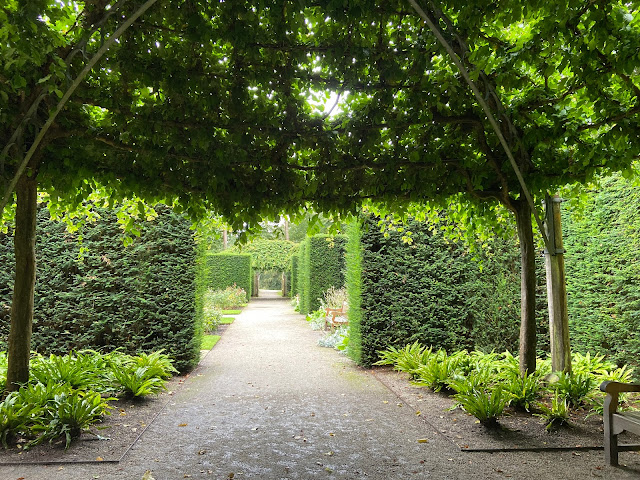EARLY FEBRUARY IN THE GARDEN
It has been pleasant to be the garden this week, particularly on the days when the wind has dropped. It has been a mild week, so no frozen fingers, and dry so no soggy gloves either.
The woodland garden is the first part of the garden to show signs of Spring, with the aconites and snowdrops coming into flower.
But look - what are those little leaves just on the left of the photo?
And look here, a short distance away, there are more of them. What should I do with them? Thin them out, try transplanting them, or leave well alone?
The snowdrops are getting going at last. These are the double form, which always appear before the singles.
Scattered among them, and gradually increasing year on year, are the Winter aconites.
Further patches of snowdrops inhabit the shrubbery under the oak tree.
This maple tree is forming new buds. I take all my photos of this blog on the iPhone these days, but I found it surprisingly difficult to get it to focus on these rather than the tree behind.
New buds are also forming on the roses. I've been thinking about the timing of rose pruning. I had originally intended to get it all completed by the end of February. It had drifted on until mid March last year. From going on a rose pruning course at David Austin roses a few years ago, I know they start theirs around Christmas time and finish by the end of February. I read another garden writer who said she prunes hers in March though.
Mine however seem to be raring to go and it seems sensible to get rid of the old black spotted foliage before the new leaves emerge, so I got on with the pruning and now it's nearly all done.

Isn't nature wonderful?
See you next week. Don't forget all the Six on Saturday posts can be found on Garden Ruminations our new home from home thanks to Jim who is caretaking while the Propagator takes a break.












What lovely paintings. I fear the squirrels have munched on some of the bulbs that I've planted, I shall have to be sneaky next year - although I can't think how yet!
ReplyDeleteI assume planting deep will help, but that's difficult with cyclamen.
DeleteN20. Such lovely paintings. I have also tackled 'Mad Alf' this week. She is a character. I hope I have done her justice. I like to prune my roses from December but couldn't this year. Now the tulips are pushing through and I have to be very careful not to trample them. Seeing the new growth on the roses does help so I'm happy with an early Feb prune for a change.
ReplyDeleteI had bought those roses to go over an arch (in my inexperienced garden days) and thankfully I didn't plant them there. She does put on a fair bit of growth!
DeletePretty watercolor! Bravo. The winter aconites are also pretty and the carpet they form must be wonderful at this time of year since there are not many colours
ReplyDeleteAlthough bright yellow is not my favourite colour, at this time of year they seem just right.
DeleteThe Cyclamen Society recommendation for seedlings in pots is not to transplant until their second season, when the corms have turned from translucent to brown, and to do so when they are dormant in summer. You'd need to mark them carefully or they'd be hard to find.
ReplyDeleteThanks for that Jim.
DeleteI'm with Jim for ones in the ground too, but you have so many there, that a few quickly transferred to a seed pan and kept growing for as long as possible would be worth it. In a pan you are able to give them protection and with water and shade you will have larger corms sooner.
ReplyDeleteThanks. I'll move a few and cross my fingers.
DeleteI do love a wood! Lovely to see the late winter/early spring bulbs doing their bit. Beautiful water colour, you are very clever!
ReplyDeleteThanks Gill
DeleteLovely crocus, and the watercolors capture the delicate beauty! Nice job!
ReplyDeleteThank you
DeleteBeautiful pictures of your garden and beautiful paintings. I’m envious of your garden and your painting ability. I’ve tried with Aconites several times but they don’t return. It’s a seldom seen flower in my area.
ReplyDeletethequiltinggardener
That's a shame about the Aconites. Luckily these were already here, although they are only spreading very slowly.
DeleteI too have problems with aconites, they never seem to return except for just one! I planted about 50 crocus in my lawn, the oak tree next door dropped hundreds of acorns on top and the squirrel found my crocus when it was burying the acorns, I think I might have about 10 left, I might move those to the woodland to protect them!
ReplyDeleteSquirrels are a nuisance. They once went through all the early tulips I'd planted.
ReplyDeleteBeautiful paintings - am jealous of the self-sowing crocus, since they don't seem to be too happy with me!!! Lovely to see your garden - it's beautiful and your cyclamen are really thriving aren't they (I'd let them get on with it, but that's probably because when I meddle with something successful it seems to go wrong!) Have a good week.
ReplyDeleteThanks Cathy
Delete